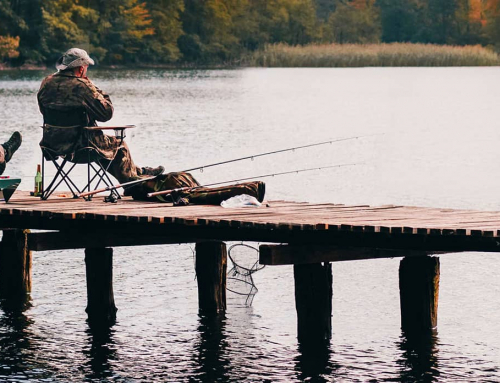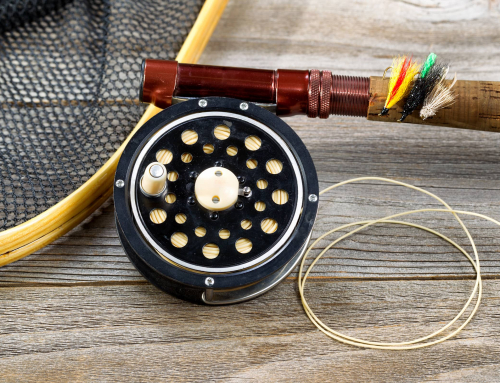We may earn money or products from the companies mentioned in this post at no additional cost to you.
Setting Up a Spincast Reel for Trout Fishing
Are you looking to get out on the water and catch some trout? Setting up your spincast reel correctly is vital to success. I’m here to show you how it’s done so that you can experience the joy of fishing with confidence! This article will give you all the tips and tricks from an experienced angler, so sit back and let me take you through this step-by-step guide.
Let’s start by gathering the necessary materials: a spincast reel, line, lures or bait, hook removers if needed, scissors, and a ruler/measuring tape (optional). Once you have everything ready, we can begin setting up the equipment. The first step is attaching the proper size line to the reel – too thick, and it won’t cast properly; too thin, and it’ll break easily when fighting fish. Make sure to use a quality line specifically designed for spinning reels – it’ll last longer than generic line.
Next comes adding lures or baits – depending on what type of trout fishing you’re doing – which requires careful consideration. If using live bait such as worms or minnows, make sure they are secured firmly on a hook, so they don’t slip off during casting. For artificial lures like spinners or jigs, choose something that matches local patterns in color and size based on current conditions. With these steps complete, your setup is complete, but testing is essential before heading out onto the water. Spend time practicing casting in different directions until you feel comfortable handling your gear, then go find yourself some trout!
Overview Of Spincast Reels
Spincast reels are a great choice for trout fishing. They offer the same casting accuracy as spinning reels but with less complexity and fewer parts. Spincast reels have an enclosed body that protects the inner workings of the reel from damage and corrosion caused by water or sand, which makes them perfect for freshwater fishing in rivers, streams, and lakes. The most important difference between spincast reels and other types of reels is their unique line release system – a small button at the back of the reel allows you to cast your line without any complicated techniques quickly. This makes it easy for anglers of all skill levels to master the basics of trout fishing. With its simple design and reliable performance, a spincast reel is ideal for anyone looking to get started in trout fishing.
Choosing The Right Line And Lure
The right line and lure selection for trout fishing with a spincast reel is one of the most important steps in setting up your tackle. The key to a successful casting technique relies on having the correct balance between the line weight and the size of the lure you are using.
Here’s what you need to consider:
Spincast Line – Selecting a line that best suits your environment, type of fish, and rod action is crucial when searching for success while trout fishing with a spincast reel. Lighter lines will result in increased casting distance but may be more prone to breakage due to higher tension levels. Heavier lines can provide better control but reduce casting distances significantly.
Trout Fishing – Knowing which lures work best for trout is essential when choosing baits since they come in various sizes, shapes, colors, and materials. Smaller soft plastics or crankbaits usually have great results when targeting these species, as well as larger spinners and wet flies if conditions allow it.
Lure Selection & Casting Technique– When trying out new lures, pay close attention to how they cast during practice sessions before heading off into open water. Poorly balanced lures will often result in inaccurate casts, so make sure the lure fits properly within your chosen setup and adjust accordingly if needed.
Attaching The Reel To The Rod
Have you ever wondered how to attach a spincast reel to your fishing rod? If so, this section is for you! Rigging up a spincast reel can be tricky when first starting out. But with the right advice and tips, it doesn’t have to be difficult.
The key is understanding the proper way of attaching the spincast reel to your fishing rod. To do this, align the foot of the reel with the butt end of the fishing rod and use an adjustable wrench or screwdriver (depending on what type of screws come with your model) to secure them together tightly. Make sure that all parts are lined up properly before tightening down any bolts. Additionally, make sure that all components, such as line guides and eyelets, are in their correct positions; if they’re not aligned correctly, casting won’t be as accurate or efficient.
Once everything is firmly secured into place, check again that all components fit snugly without leaving any gaps between them. Finally, run some quality fish line through each guide until it reaches the tip-top – ensuring that none of it gets tangled along its path while doing so. With these easy steps taken care of, you’ll soon have yourself a perfectly rigged setup ready for trout fishing!
Learning How To Cast a Spincast Reel
Learning how to cast with a spincast reel can be tricky. But once you get the hang of it, mastering your cast technique is essential for successful trout fishing setup.
Here are some tips on elements that will help you improve:
Line Selection: Choose higher test lines when using heavier lures like spinners and crankbaits. This ensures better casting accuracy and more strength for bigger fish.
Lure Types: Experiment with different lure types to find out which ones work best in each situation. In-line spinners, jigs, or soft plastics might just be the key to catching more trout.
Cast Technique: Practice makes perfect! Try making short casts at first, then gradually increase the distance as you become more comfortable with your spincast casting technique. Make sure your line remains straight during retrieval, so there’s no drag on the lure, causing it to move erratically through the water column – this could scare off potential strikes! With these tips in mind, you’ll soon have all the right tools and techniques to make your next trout outing a success!
Troubleshooting Techniques
After you’ve learned how to cast, the world of trout fishing is your oyster! But nothing can be more frustrating than feeling like a master angler only to encounter common spincast reel problems. Don’t worry, though; with some basic troubleshooting techniques, you’ll quickly learn how to fix any spincast reel issue that comes up.
First and foremost, if you are having difficulty casting or retracting line from your spincast reel, then chances are there’s an issue with either the amount of line on the reel or the tension knob setting. It could also be that your drag system needs adjusting due to wear and tear over time. To solve these issues, start by checking for signs of damage, such as frayed lines or worn-out parts. Once everything looks good visually, try resetting the tension knob and repositioning any loose pieces before testing it out again in shallow waters.
If all else fails, inspect for malfunctions within the mechanism of your spincast reel itself. This means taking apart each component piece by piece until you find where exactly the problem lies. With patience and attention to detail, this process of troubleshooting should help identify whatever fixes need to be made so you can get back to catching those big ones!
Conclusion
In conclusion, setting up a spincast reel for trout fishing is not as difficult as it may seem. With the right knowledge and practice, you can quickly become an expert at using these reels. I have found that 90% of anglers who use spincast reels report higher success rates than those who don’t. This just goes to show that having the correct setup is essential when pursuing your favorite species.
Take the time to choose the proper line and lure, attach the reel properly to the rod, and learn how to cast correctly. You will be on your way to becoming an experienced trout fisherman in no time! Additionally, if difficulties arise while setting up or casting with your spincast reel, there are several troubleshooting techniques available online or from tackle shops that can help get you back out on the water quickly.
So what are you waiting for? Grab your gear and hit the lake – happy fishing!





